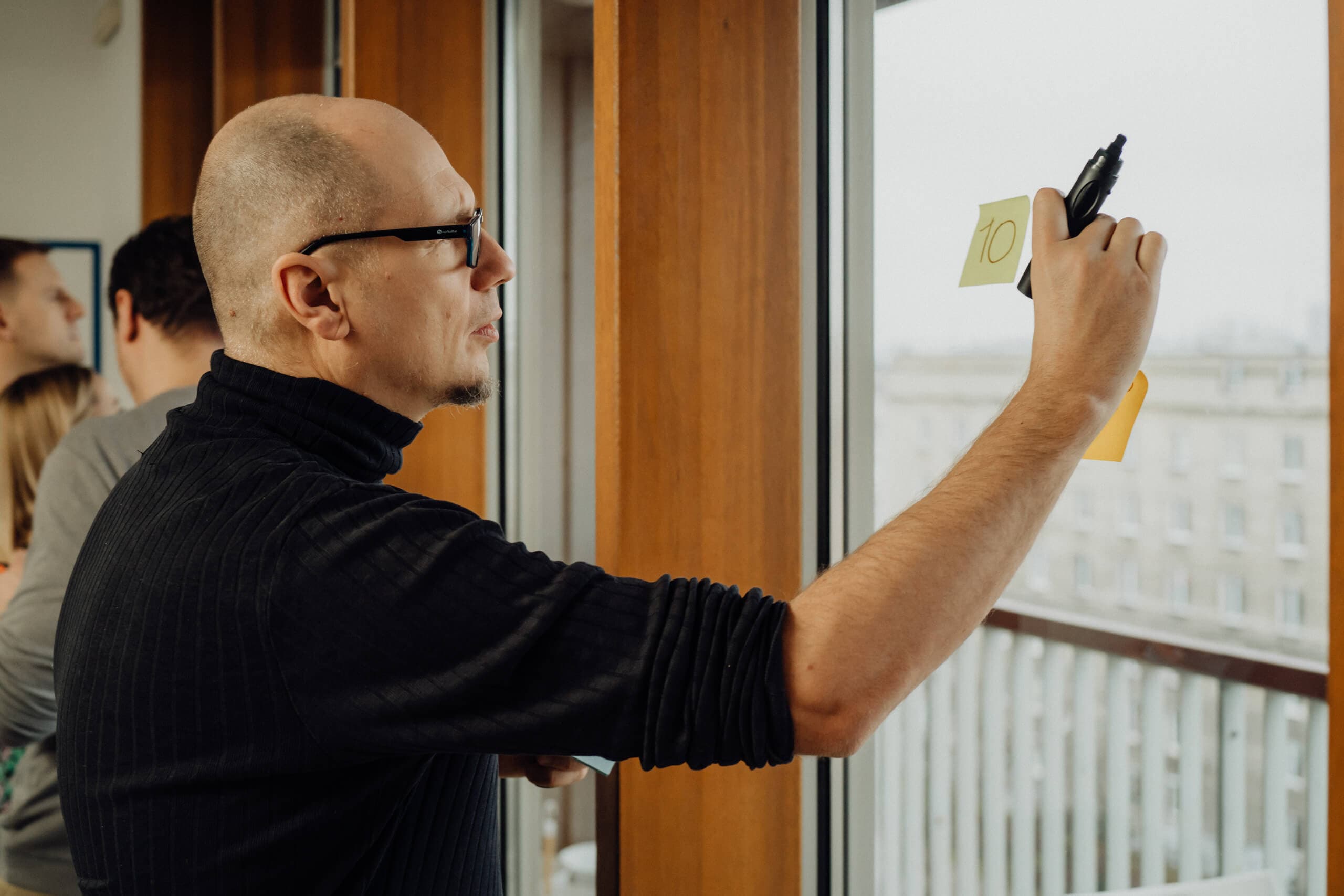Advantages of In-depth User Interviews

Ewa Rutczyńska-Jamróz
May 29, 2022・12 min read
Table of Content
What is an in-depth interview method?
Advantages and disadvantages of interviews
Benefits of interviews
Disadvantages of interviews
Understanding the in-depth interview process
How to conduct user interviews
Why is it worth conducting user interviews?
The role of the interviewer
Getting the perspectives of target users is invaluable to the product development process. There are numerous qualitative data collection methods that can be used to achieve this, and in-depth interviews are among the most effective.
But they are not necessarily the easiest. They require solid preparation as well as specific skills and predispositions in the interviewer.
So here's what you should know about in-depth interviews.
What is an in-depth interview method?
User interviews are an example of a qualitative data collection method. They are aimed at exploring the opinions, perspectives and feelings of the target audience and provide vital information that in turn can influence the final characteristics of a product or service.
The key to effective in-depth interviews is an open questioning format. This creates clearer opportunities to explore participants' thoughts and opinions on a deeper level.
As such, it is a method focused on the quality of data, not quantity and is therefore employed in smaller-sized groups as opposed to those of a focus group or a conducted survey.
An in-depth interview requires the direct engagement of both sides in the process –, the interviewer and the participant. In-person meetings are the most effective way to do this.
Here, the interviewer has a chance to observe the user and adjust the interview scenario accordingly. An in-depth interview can also be conducted remotely (i.e. via online meeting or phone).
However, this requires ever more preparation and experience from the interviewer to avoid potential data loss.
Generally speaking, an interview can be structured or unstructured depending on its purpose and circumstances. For the in-depth interview, however, the best formula is semi-structured.
This approach helps define what you wish to learn from the user, and also allows the flexibility to ask additional questions and explore new threads of inquiry based on the participant's responses.
According to the State of UX in the Enterprise survey prepared by UserZoom, in-depth interviews are the preferred UX research method by respondents. They now exceed A/B testing, surveys, and focus groups, and owe their leading position to the numerous advantages we will now explore.
Interviews can be conducted at many different stages of the product development process. However, they are invaluable in terms of searching for justification for the product idea.
They can provide insightful feedback during user testing (e.g. how the problem is being solved now, what can be done differently from the user's perspective). Interviews are also a great way to evaluate a product or service against user experience as part of usability testing.
Learn more about the user and usability testing from our previous blog post.
Advantages and disadvantages of interviews
Once we have an understanding of what user interviews are, it is time to investigate the pros and cons of in-depth interview qualitative research.
One prominent advantage of in-depth interviews is that they provide the insight and potential to uncover valuable findings for your business.
On the other hand, in-depth interview techniques are the most demanding in terms of resources involved (i.e. time, money, people).
Below we illustrate further leverages you can gain through the in-depth interview and some of the drawbacks that may accompany them.
Benefits of interviews
Quality of findings
Quantity research techniques can help you to quantify the needs of the target audience. This is why an in-depth interview is a great way to learn what specific issues are behind the numbers. In most cases, surveys do not allow the participants to go beyond the question.
Direct engagement of the interviewer and the use of open-ended questions can lead the user to share more profound insights. Indeed, a single, well-conducted interview can often reveal far more than multiple surveys will.
The advantage lies in the flexibility to react and to dig further into details when necessary. And often it is these details that provide a fundamental advantage to your business.
Time to react
The fact that you can get immediate results during the in-depth interviews means you can then adjust your next steps accordingly. This can save a lot of your resources now and in future.
Small sample, rich content
People are more willing to share their opinions in an in-person meeting rather than writing them in a survey.
When a well-prepared interviewer has the appropriate soft skills and the participant is ready for engagement, a more comfortable relationship can be formed to accommodate detailed discussion and ensure greater ease in exploring sensitive issues.
The interviewer can also use the participant's body language and tone of voice as indicators of how to react accordingly to these details and issues.
Given the depth of insight and honesty that may therefore be gained in the interview format, as a general rule, the procedure requires far fewer participants.
Comprehensive feedback
In-depth interviews can be used as a standalone method and also in support of quantity gathering techniques -- especially in cases when the numbers are hard to interpret.
Sometimes the numbers themselves say nothing. However, when interpreted via the insight gained through an interview, they can do much to improve the product's chances of success.
Hidden opportunities
In-depth interviews are a great way to make much progress in the early stages of the product development process. They are invaluable in terms of getting to know the target audience (behavior, attitude, feelings, perception) and finding product-market fit.
But their strength goes much deeper. Focusing on what users need and want is also key to identifying the hidden opportunities for your business.
Disadvantages of interviews
Resources involved
Conducting user interviews is not easy and requires many resources:
time - much is often required for both parties in the process
money - financial resources are required for creating proper conditions for the interview (e.g. for securing premises and training etc.)
people - the interview must be conducted by an appropriate employee who is fully prepared and engaged so as to avoid any data loss
If you want to maximize your time with the user, you should offer incentives. Incentivization will make people more willing to sacrifice their time for the interview and is a factor that should be considered when planning a budget.
Quality of sample
It may happen that a group or individual selected for the interview does not accurately represent that of the target audience. This can result in equally inaccurate and therefore deeply problematic conclusions being drawn from the procedure.
But this risk is not only related to this research method. It can also occur in focus groups and surveys. In fact, the sampling is more accurate in the interviews than in other techniques.
Still, vigilance in both the selection of the group and the interpretation of the results should not be forgotten.
Summarizing conclusions
In-depth interviews are a real challenge in terms of summarizing their results. On the one hand, when the sample is small there are relatively few interviews to analyze.
On the other hand:
Open-ended questions and a flexible structure can require extensive notetaking that will require later review and summarization
It can be difficult to compare participants given their particular interviews can lead in different directions
Generalizations become problematic when interviews are focused on individual opinions
Confronting in-depth interviews with other research methods can be supportive during the process of summarizing and concluding.
Understanding the in-depth interview process
Based on "Conducting An In-Depth Interview" (issued by the University of Florida) there are 7 stages of conducting in-depth interviews. They are as follows:
How to conduct user interviews
Stage 1: Thematizing
Define:
What is the purpose of an interview?
Will it be the only method or a combined process using other data collection techniques?
What key information do you wish to gain from the user?
Stage 2: Designing
An in-depth interview is a mix of flexibility and structure. It cannot be planned in its entirety, nor can it be run without a framework. Therefore, a guide is required.
This guide should include key topics and questions. Its role is to maintain focus on the most important aspects whilst allowing for observation and additional questioning.
Stage 3: Interviewing
Each interview requires an introduction and an explanation of its purpose. Questions should then be asked attentively. Read body language; take notes. Ensure all topics of the in-depth interview guide are covered before concluding the interview.
Stage 4: Transcribing
This stage concerns the proper documentation of each user interview. If the interview was recorded, a transcription of it will be required.
Stage 5: Analyzing
Any interview will lack purpose when not subject to thorough analysis. A guide from stage 2 can be very effective for finalizing conclusions.
Stage 6: Verifying
The feedback obtained during the interview is valuable only if it is credible. It may occur that the involvement of another person will be required to check if the conclusions can be considered valid, i.e. if both sides interpret the conclusions in the same way.
Stage 7: Reporting
Depending on the purpose of in-depth interviews, it may be necessary to report the outcomes to the stakeholders. The results should include all conclusions as well as any suggestions for the next steps (e.g. changes in the product design).
Apart from understanding the particular stages, it's worth remembering some important issues for conducting an effective in-depth interview:
Learn more about the respondent before you invite him/her for an interview to assure the quality of the sample
Set a time frame for the interview so that the participant is aware of how much time will be required
Chose a comfortable location
Chose the right questions so that the participants are encouraged to share their honest thoughts and opinions
Avoid leading questions that can influence participants’ answers
Make a recording of the interview so that all data is saved
Make notes on changes in tone of voice and of any significant body language gestures observed
Adhere to all ethical rules
Why is it worth conducting user interviews?
According to Zendesk and its "CX Trends 2022" report, 76% of respondents claim they would switch to a company’s competitor in response to multiple negative customer-service experiences.
Based on "37 customer experience statistics you need to know for 2022", customer experience will remain the No 1 priority for the business over the next 5 years. It's even more important than a product or a service itself (No 2 on the list).
In-depth interviews have the power to close the gap between the business vision and customer experience. Why? Because of the familiarity that is established with the user; with his/her feelings, thoughts, perspectives and values.
And this gives you rich content to be used in planning your business, including product design and features, marketing strategy, unique selling points, etc. This is how you increase the chances of your product or service being accepted in the market.
Despite the disadvantages presented above (which we should consider instead as challenges that are to be managed accordingly), a user interview is one of the most effective qualitative data collection techniques in use.
As always, choosing a method must be preceded by analysis and is determined by many factors, including its purpose and budget. Whichever method you choose, remember these important requirements for effective in-depth interviews:
They must be guided, but not overly regimented
They should feature a mix of flexibility and structure (a semi-structured agenda)
In-depth interviews should provide the opportunity to interact with and follow the participants
They should foster the right conditions for engaging and accommodating the participant and his/her opinions and feelings
In-depth interviews should employ techniques for penetrating and exploring the user's point of view.
Vigilance must be practised in both user selection and data interpretation
The role of the interviewer
The success of in-depth interviews very much depends on the competencies of the interviewer. According to "Conducting an in-depth interview" by the University of Florida, such a person should have the following characteristics:
Open-mindedness
Flexibility and responsiveness
Patience
Perceptiveness
Advanced attentiveness; the ability to summarize, paraphrase and reflect back to the user
A perfect candidate for an interviewer is a highly empathetic person with strong soft skills. The right person for that job ensures the participant feels comfortable during the interview whilst collecting all relevant feedback and avoiding any data loss. These are uncommon skills.
Without them, an interviewer may jeopardize the interview process, in which case the involvement of an external specialist may prove the superior option.
At Startup Development House, we turn ideas into real-life products. As part of the process of user and usability testing, we conduct a series of tailor-made in-depth interviews. We believe that this is an ideal way of gaining honest, insightful feedback.
Our experience proves that properly organized, in-depth interviews have the power to truly validate a business concept, challenge and test it with user experience, and ultimately increase its chances of market success.
Do you have an idea for an application or other digital product? Contact us and together we'll explore its users' genuine perspectives.
Digital Transformation Strategy for Siemens Finance
Cloud-based platform for Siemens Financial Services in Poland


You may also like...

The Ultimate Guide to Hire .NET Developers: What You Need to Know
Navigating the process of hiring .NET developers can be challenging, but understanding the essential skills and qualities can make it easier. This guide provides practical advice on what to look for when hiring .NET developers, ensuring you select candidates who can build robust, scalable applications that meet your project's needs. Whether you're experienced in hiring or new to the process, this resource will help you make confident and informed decisions.
Marek Pałys
May 21, 2024・9 min read

Streamline Tour Operations with Travel Operator Tour Dispatch SaaS Solutions
Travel operator tour dispatch SaaS solutions revolutionize tour management by automating and optimizing dispatch processes. These solutions improve efficiency, reduce costs, and enhance customer satisfaction, helping travel businesses stay competitive in the digital age.
Marek Majdak
May 27, 2024・9 min read

The Ultimate Guide to Prompt Tuning: Boosting Efficiency and Maximising Performance
Prompt tuning stands as a critical technique for maximizing AI efficiency and performance, enabling precise model adjustments without extensive retraining. This guide dives into the nuances of prompt tuning, detailing how to craft effective prompts, avoid common pitfalls, and measure success. By embracing prompt tuning, users can unlock the full potential of AI applications, ensuring their models remain responsive, accurate, and aligned with evolving requirements.
Marek Majdak
Jan 18, 2024・9 min read
Let’s build your next digital product — faster, safer, smarter.
Book a free consultationWork with a team trusted by top-tier companies.








